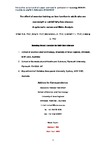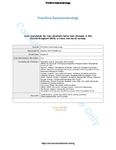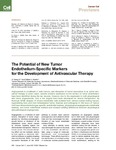Effect of exercise training on liver function in adults who are overweight or exhibit fatty liver disease: a systematic review and meta-analysis
| dc.contributor.author | Smart, NA | |
| dc.contributor.author | King, N | |
| dc.contributor.author | McFarlane, JR | |
| dc.contributor.author | Graham, PL | |
| dc.contributor.author | Dieberg, G | |
| dc.date.accessioned | 2016-08-15T11:40:29Z | |
| dc.date.available | 2016-08-15T11:40:29Z | |
| dc.date.issued | 2016-06-17 | |
| dc.identifier.issn | 0306-3674 | |
| dc.identifier.issn | 1473-0480 | |
| dc.identifier.uri | http://hdl.handle.net/10026.1/5299 | |
| dc.description.abstract |
<jats:sec><jats:title>Objective</jats:title><jats:p>Exercise training has been shown to have beneficial effects on liver function in adults overweight or with fatty liver disease. To establish which exercise programme characteristics were likely to elicit optimal improvements.</jats:p></jats:sec><jats:sec><jats:title>Design</jats:title><jats:p>Systematic review and meta-analysis of randomised, controlled trials.</jats:p></jats:sec><jats:sec><jats:title>Data sources</jats:title><jats:p>PubMed, CINAHL and Cochrane controlled trials registry searched (1966 to 2 October 2015).</jats:p></jats:sec><jats:sec><jats:title>Eligibility criteria for selecting studies</jats:title><jats:p>Exercise intervention, with or without dietary intervention, versus usual care in adults undertaking, exercise training, who were overweight, obese or exhibited fatty liver disease (non-alcoholic fatty liver disease or non-alcoholic steatohepatitis).</jats:p></jats:sec><jats:sec><jats:title>Results</jats:title><jats:p>We included 21 randomised controlled trials, totalling 1530 participants. Exercise intervention studies with total exercise programme workload >10 000 kcal produced significant improvements in intrahepatic fat, −3.46% (95% CI −5.20% to −1.73%), p<0.0001, I<jats:sup>2</jats:sup>=73%; effect size (standardised mean difference, SMD) −1.77 (−3.11 to −0.42), p=0.01, I<jats:sup>2</jats:sup>=77%. When data from only exercise studies were pooled, there was a reduction in fasting free fatty acids (FFAs) −74.15 µmol/L (95% CI −118.47 to −29.84), p=0.001, I<jats:sup>2</jats:sup>=67% with a large effect size (SMD) −0.94 (−1.36 to −0.52), p<0.0001, I<jats:sup>2</jats:sup>=0%. When data from only exercise studies were pooled, there was a significant reduction in insulin MD −1.88 UL (95% CI −3.43 to −0.34), p=0.02, I<jats:sup>2</jats:sup>=31%. The liver enzymes, alanine aminotransferase, aspartate aminotransferase and γ-glutamyl transpeptidase, were not significantly altered with exercise.</jats:p></jats:sec><jats:sec><jats:title>Conclusions</jats:title><jats:p>Exercise training reduces intrahepatic fat and FFAs while increasing cardiorespiratory fitness. An aggregate exercise programme energy expenditure (>10 000 kcal) may be required to promote reductions in intrahepatic fat.</jats:p></jats:sec> | |
| dc.format.extent | bjsports-2016-096197-bjsports-2016-096197 | |
| dc.format.medium | Print-Electronic | |
| dc.language | en | |
| dc.language.iso | en | |
| dc.publisher | BMJ | |
| dc.subject | Evidence based review | |
| dc.subject | Liver | |
| dc.subject | Meta-analysis | |
| dc.subject | Prevention | |
| dc.subject | Adiposity | |
| dc.subject | Exercise Therapy | |
| dc.subject | Fatty Acids | |
| dc.subject | Humans | |
| dc.subject | Liver | |
| dc.subject | Non-alcoholic Fatty Liver Disease | |
| dc.subject | Overweight | |
| dc.subject | Randomized Controlled Trials as Topic | |
| dc.title | Effect of exercise training on liver function in adults who are overweight or exhibit fatty liver disease: a systematic review and meta-analysis | |
| dc.type | journal-article | |
| dc.type | Journal Article | |
| dc.type | Meta-Analysis | |
| dc.type | Review | |
| dc.type | Systematic Review | |
| plymouth.author-url | https://www.webofscience.com/api/gateway?GWVersion=2&SrcApp=PARTNER_APP&SrcAuth=LinksAMR&KeyUT=WOS:000438038900010&DestLinkType=FullRecord&DestApp=ALL_WOS&UsrCustomerID=11bb513d99f797142bcfeffcc58ea008 | |
| plymouth.issue | 13 | |
| plymouth.volume | 52 | |
| plymouth.publication-status | Accepted | |
| plymouth.journal | British Journal of Sports Medicine | |
| dc.identifier.doi | 10.1136/bjsports-2016-096197 | |
| plymouth.organisational-group | /Plymouth | |
| plymouth.organisational-group | /Plymouth/Faculty of Health | |
| plymouth.organisational-group | /Plymouth/Faculty of Health/School of Biomedical Sciences | |
| plymouth.organisational-group | /Plymouth/REF 2021 Researchers by UoA | |
| plymouth.organisational-group | /Plymouth/REF 2021 Researchers by UoA/UoA03 Allied Health Professions, Dentistry, Nursing and Pharmacy | |
| plymouth.organisational-group | /Plymouth/Users by role | |
| plymouth.organisational-group | /Plymouth/Users by role/Academics | |
| dc.publisher.place | England | |
| dcterms.dateAccepted | 2016-05-31 | |
| dc.identifier.eissn | 1473-0480 | |
| dc.rights.embargoperiod | Not known | |
| rioxxterms.versionofrecord | 10.1136/bjsports-2016-096197 | |
| rioxxterms.licenseref.uri | http://www.rioxx.net/licenses/all-rights-reserved | |
| rioxxterms.licenseref.startdate | 2016-06-17 | |
| rioxxterms.type | Journal Article/Review | |
| plymouth.oa-location | http://bjsm.bmj.com/content/early/2016/06/17/bjsports-2016-096197 |





